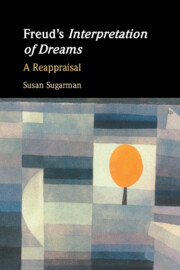Book contents
- Freud’s Interpretation of Dreams
- Freud’s Interpretation of Dreams
- Copyright page
- Dedication
- Contents
- Acknowledgments
- Introduction
- Part I The Interpretation of Dreams (1900)
- A Note on Freud’s Text
- 1 The Interpretation of Dreams (1900), Chapters I–IV
- 2 The Interpretation of Dreams (1900), Chapters V and VI
- 3 The Interpretation of Dreams (1900), Chapter VII
- 4 The Interpretation of Dreams (1900)
- Part II Freud’s Other Works
- Conclusion
- References
- Index
2 - The Interpretation of Dreams (1900), Chapters V and VI
If Dreams Fulfill Wishes, Then with What Material, and How, Might They Form?
from Part I - The Interpretation of Dreams (1900)
Published online by Cambridge University Press: 18 November 2022
- Freud’s Interpretation of Dreams
- Freud’s Interpretation of Dreams
- Copyright page
- Dedication
- Contents
- Acknowledgments
- Introduction
- Part I The Interpretation of Dreams (1900)
- A Note on Freud’s Text
- 1 The Interpretation of Dreams (1900), Chapters I–IV
- 2 The Interpretation of Dreams (1900), Chapters V and VI
- 3 The Interpretation of Dreams (1900), Chapter VII
- 4 The Interpretation of Dreams (1900)
- Part II Freud’s Other Works
- Conclusion
- References
- Index
Summary
Freud next elaborates consequences of the structure he has postulated, as he examines the material dreams use (his Chapter V) and the mechanisms by which they reach their manifest form (his Chapter VI). The former investigation allows us to see whether his conception illuminates characteristics of dreaming he has not yet considered, like its favoring of recent and indifferent impressions. The latter effort – his delineation of the means by which the underlying “latent,” wish-fulfilling content of dreams changes into its manifest form – assumes the theory without providing any additional grounds for its evaluation. His fifth chapter turns out, on inspection, also assumes the theory.
A novel contribution of the fifth chapter is the assertion that dreams serve to guard sleep. The sixth chapter introduces the idea that dreaming is a primitive mental process. Freud overstates the case for the former and has yet to elaborate the import of the latter.
- Type
- Chapter
- Information
- Freud's Interpretation of DreamsA Reappraisal, pp. 39 - 60Publisher: Cambridge University PressPrint publication year: 2022



